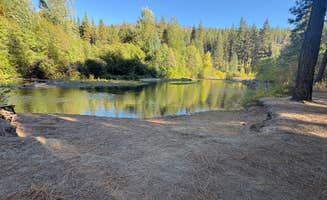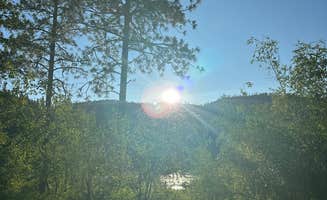Dispersed camping in the Okanogan Highlands near Tonasket, Washington offers primitive sites on public lands managed by federal agencies. The area sits at elevations ranging from 1,200 to 4,000 feet with a semi-arid climate that creates distinct camping seasons. Road conditions deteriorate significantly after rainfall, particularly on forest service roads accessing more remote sites.
What to do
Fishing opportunities: Blue Lake North provides good fishing access with "several points of access to the lake" according to Mike D., who notes it's a "beautiful lake, long, big and I hear they have fish." The lake remains accessible from early May through late October.
Wildlife observation: Sidley Lake offers excellent wildlife viewing opportunities throughout the day and night. Teresa H. shares that "Loons and Coyotes are great music. Beautiful Lakes (Sidley & Molson) near historical Old Molson!" This lake also provides winter recreation as "the town has an ice fishing tournament every winter."
Hiking trails: Black Lake Backcountry Campsite requires hiking to access but rewards visitors with "awesome lake access" according to Jeff C., who described it as "a wonderful site" for backpacking. The trailhead may require a high-clearance vehicle during spring thaw conditions.
What campers like
Peace and quiet: Sullivan Pond Camp receives consistent praise for its tranquility. Emma T. describes it as a "really peaceful and lovely campsite. Lots of flowers, just a few camping spaces available." This smaller dispersed area provides a sense of seclusion compared to more developed campgrounds.
Solitude during weekdays: Free camping near Tonasket, Washington tends to be less crowded on weekdays, even during summer. At Upper Bobcat Dispersed Camping, Emma observed "Lots of room at your site and between neighbors. Super close to the river." She noted a family-friendly atmosphere that "made me feel safer as a solo traveler."
Proximity to attractions: Goat Creek Sno-Park serves as a practical base camp for exploring the region. Ashley A. calls it a "great place just to sleep and keep moving," and Anna P. notes it's "close to the national park" with "a hitching post and a trail that leaves from the campground."
What you should know
Permit requirements: Washington Discover Pass is required for most dispersed camping near Tonasket. John T. specifically mentions this requirement for Sullivan Pond Camp, and Emma T. confirms "Washington Discovery Pass is required for camping here."
Access challenges: High-clearance vehicles are recommended for many sites. John T. advises visitors to Sullivan Pond Camp to have "4wd with good clearance" to navigate the forest roads safely.
Insect preparation: Mosquitoes are prevalent at many waterside locations. At Upper Bobcat, PJ H. reported that "bugs were BAD, like hiding in the car and tent bad. Left with more bug bites than I could count." Jeremy M. similarly warns about Sullivan Pond: "Quite a few mosquitos do bring spray or other repellant types."
Limited facilities: Most no-cost camping around Tonasket provides minimal amenities. Forde Lake is described by Mike D. as "a dry Camp only, no water/power ect." Al M. adds that "mosquitoes are present" and notes the "gravel road is fairly busy with plenty of dust boiling up."
Tips for camping with families
Site selection: At Forde Lake, Al M. suggests: "I recommend not taking the first site in even though it looks like it would accommodate a 40 ft rig. Four of the sites looked able to handle our 27 ft trailer. A few are slide in camper sized."
Safety considerations: Upper Bobcat offers good options for families with children as it tends to attract similar groups. Emma noted that "There were a lot of people, mainly families, but everyone was super respectful."
Nearby attractions: Consider visiting historical sites in the area. Near Sidley Lake, Teresa H. mentions the "historical Old Molson" which provides an educational opportunity for children when not at camp.
Tips from RVers
Site dimensions: For RV camping near Tonasket, Washington, Forde Lake has limited large sites. According to Al M., "The campground has 10 sites... Four of the sites looked able to handle our 27 ft trailer," indicating most sites accommodate smaller rigs only.
Overnight parking: Goat Creek Sno-Park functions well for overnight stays. Anna P. describes it as a "Big open lot where you can easily park cars/campers/RVs/etc. Lots of space and room to pitch tents along the edges." Ashley A. adds it's "Nothing special. Just a parking lot a little off the highway. People are rolling in until about 10:30 and start leaving at 6."





